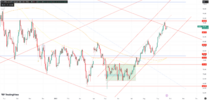Zforex
zForex.com Representative
- Messages
- 30
Apple's stock declined by 2.9% following a Bloomberg News report indicating that China might expand its ban on the use of iPhones in state-owned entities and agencies. This led to a downturn in technology and semiconductor stocks, with Nvidia and Advanced Micro Devices seeing drops of 1.7% and 2.5%, respectively. Seagate Technology experienced a significant decline of nearly 11%, while Skyworks Solutions, Qualcomm, and Qorvo saw reductions of at least 7%.
On Thursday, a series of economic data points, including lower-than-expected jobless claims, raised concerns that the Federal Reserve might reconsider its tight monetary policy stance due to the robust labor market. Weekly jobless claims stood at 216,000, below the Dow Jones estimate of 230,000, and second-quarter labor costs increased more than anticipated.
The recent rise in energy prices, coupled with a strong job market, could prompt the Federal Reserve to take further action, potentially approving more interest rate hikes, as stated by Zaccarelli.
While 93% of traders are currently pricing in a rate pause at the September Federal Open Market Committee meeting, the possibility of additional hikes in November has increased to approximately 43%, according to the CME Fed Watch tool.
Nasdaq is coming back to the 15,300-support level as support right now and heading towards the 16,000 mark, its previous peak. This higher level presents a formidable challenge for further advancement. Notably, media coverage appears to be providing solid support for the price, and even the bearish pattern that was emerging earlier seems to have lost its significance.
The price increase this week was primarily fueled by Saudi Arabia's decision to prolong its production cut and Russia's extension of its export cut.
Saudi Arabia and Russia announced earlier in the week that they would maintain their production curb of 1.3 million barrels per day until the end of the year. This announcement initially led to prices reaching their highest levels in nearly a year. However, prices have since retreated due to several factors.
Factors contributing to the price retreat include concerns about Chinese demand, a strong U.S. dollar, and profit-taking by investors. Despite a report indicating robust oil demand in China, uncertainty about Chinese demand persisted. China's oil imports saw significant increases in August, but doubts remained. Additionally, the strong U.S. dollar benefited from expectations that the Federal Reserve had completed its rate hikes. Profit-taking also played a role as investors cashed in on recent price surges.
The decline in U.S. crude oil inventories over the past four weeks, with the latest estimate showing a draw of over 6 million barrels, provided support for this week's rally. Some experts pointed to these inventory draws as a sign of strong domestic demand in the largest global economy.
While there is renewed speculation about oil prices reaching triple digits and OPEC+ production cuts continue to limit downside risks, concerns about demand persist and could pose challenges in the future.
The WTI touched the higher highs at the 88 level but started forming a price action signaling a possible correction and divergence with RSI on a 4H chart. If price continues the next resistance level will be around 90.
Charles Edwards of Capriole Investments recently published a report outlining why 2024 could be a pivotal year for Bitcoin. The report highlights three key factors driving this potential: Bitcoin's role as an inflation hedge, the upcoming Halving event in April 2024, and the impact of ETF approvals.
First, Edwards defends Bitcoin's performance as an inflation hedge, citing its impressive 1000% rise from Q1-2020 to Q1-2021 in response to the Federal Reserve's massive QE packages. He asserts that Bitcoin was a remarkable inflation hedge during this period.
Secondly, Edwards emphasizes the significance of the upcoming Bitcoin Halving in April 2024, which will reduce Bitcoin's supply growth rate to 0.8% p.a., lower than that of Gold for the first time. He dismisses the notion that the Halving is already priced in and suggests that historical data and on-chain metrics indicate its importance.
Lastly, Edwards discusses the regulatory landscape, mentioning the CFTC's classification of Bitcoin as a commodity, Blackrock's Bitcoin ETF application, and the SEC's reconsideration of the Grayscale spot ETF rejection. He draws parallels to the gold ETF approval in 2004, which triggered a significant bull run.
Technically, BTC continues hovering around solid support/resistance level around the 28000 mark. The next support is expected around the 25000 level.
